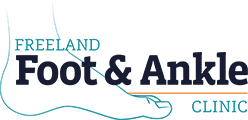Of all the foot and ankle conditions treated here at Freeland Foot and Ankle Clinic, heel pain is one of the most common. With an extensive list of root causes, from plantar fasciitis to Sever's disease, it is easy to see just how common heel pain is.
One thing is certain: heel pain is never normal. Regardless of the specific condition causing your pain, Dr. Dailey can provide effective treatment to help get you back on your feet!
Why You Have Heel Pain
We tend to take our feet for granted. They carry us through our everyday lives; thus, they face a lot of pressure. They support our body weight while standing. While walking or running, the amount of physical force placed on the feet and lower limbs is more than you think. While jogging, your heels experience force totaling up to four times your body weight.
If you have heel pain, it is likely caused by one of the following conditions:
- Plantar fasciitis. The leading cause of heel pain in adults, this condition develops when the fibrous band of tissue running along the bottom of the foot, also known as the plantar fascia, sustains small tears. It is common for plantar fasciitis sufferers to experience severe pain following sleep or extended rest periods.
- Achilles tendinitis. The Achilles tendon runs along the back of the heel. This tendon can become inflamed due to overuse, which causes pain. It is common to have the most pain during and after physical activity.
- Sever’s disease. This condition is the leading cause of heel pain in adolescents. This disease is marked by the maturation of the heel bone before the Achilles tendon is done growing. People with Sever's will often experience a painful sensation in the back of the heel, which increases with physical activity.
Of course, other conditions can be the source of your heel pain, like fractures or bursitis, but the common thread is that you should seek treatment. And that you shouldn't wait to do so. Heel pain, while common, is never normal.
Proper Treatment for Heel Pain
The good news is that conservative options can usually address the root cause of your pain. Surgery is not always necessary when it comes to heel pain.
Learn More: Say Goodbye to Stubborn Heel Pain Without the Inconvenience of Surgery
One nonsurgical option Dr. Dailey may include in your treatment plan is the use of orthotic devices. We offer over-the-counter insoles as well as custom orthotics. Orthotics are used for an array of foot and ankle conditions and can be used by patients of all ages.
Besides orthotics, strapping or padding techniques may be used to eradicate your heel pain. Cortisone injections are used in our office but are used sparingly as they are not a solution to the problem as much as they are a "band-aid" treatment to make you more comfortable while the root causes are determined.
Freeland Foot and Ankle Clinic also offers advanced treatments. EPAT (Extracorporeal Pulse Activation Technology) is a series of pressure wave treatments that stimulate and encourage the body's natural healing processes. Laser pain therapy is also available to ease inflammation and decrease pain.
Naturally, the best option is to prevent these painful conditions from developing in the first place. The common causes of heel pain are reasonably preventable.
Learn More: Why Heel Pain Doesn't Have Just One Solution
How to Prevent Heel Pain
Measures you can take to reduce your risk of developing heel pain include the following:
- Wearing Proper Shoes. There are two different ways of looking at the use of proper footwear. The first is simply making sure you have the right shoes for the sports and exercise you participate in. These shoes should fit properly and have a solid construction, cushion, and support. But beyond shoes for physical activity, your everyday shoe makes a difference too. Limiting the use of pumps and stilettos can decrease the tension in your feet and lower legs.
Learn More: 10 Podiatrist-Approved Shoes and 3 Ways to Know You've Picked a Good Shoe.
- Easing Into Physical Activity. When you dive into a new running or exercise program, you need to give your body time to adjust. This carries through to your feet and ankles. Start at a manageable level before slowly ramping up your intensity and duration over time. A good target is about a 10 percent increase per week.
- Stretching Exercises. Take about 5-10 minutes before a workout or activity to perform dynamic stretches. Preparing your body for the exercise will help prevent injuries later on. Dr. Dailey has compiled a list of his preferred stretches that target the feet and ankles, which is available in our office. We also have Thera-Band Foot Rollers in stock to help with your stretches. Simply stick the foot roller in the freezer for a few hours and use it to stretch out any tightness in that band of tissue along the bottom of your foot.
Learn More: Tips to Keep Heel Pain Away
The Care Saginaw County Deserves
The best way to know precisely why your heel hurts and what needs to be done about it is to schedule a visit to our office. We can evaluate the problem and help you decide on the treatment plan best suited for your condition and your lifestyle. Foot pain shouldn't be ignored, and we know you don't want to live in pain longer than necessary. That's why we strive to get each new patient set up with an appointment as soon as possible—no more waiting three months to see a specialist. Give us a call at (989) 695-6788, or contact us online to schedule your appointment today!
